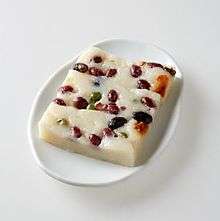Chapssal-tteok
 | |
| Alternative names | Chaltteok, glutinous rice cake |
|---|---|
| Type | Tteok |
| Place of origin | Korea |
| Associated national cuisine | Korean cuisine |
| Main ingredients | Glutinous rice |
| Similar dishes | Mochi |
|
| |
| Korean name | |
| Hangul | 찹쌀떡 |
|---|---|
| Hanja | n/a |
| Revised Romanization | chapssal-tteok |
| McCune–Reischauer | ch'apssal-ttŏk |
| IPA | [tɕʰap̚.s͈al.t͈ʌk̚] |
| Hangul | 찰떡 |
| Hanja | n/a |
| Revised Romanization | chaltteok |
| McCune–Reischauer | ch'alttŏk |
| IPA | [tɕʰal.t͈ʌk̚] |
Chapssal-tteok (찹쌀떡; "glutinous rice cake"), also called chaltteok (찰떡), is a tteok (rice cake) made of glutinous rice.[1]
Etymology
Chapssal-tteok (찹쌀떡) is a compound consisting of the noun chapssal (찹쌀) meaning "glutinous rice" and the noun tteok (떡) meaning "rice (or occasionally other grain) cake". The word chapssal derived from the Middle Korean chɑl () meaning "glutinous" and psɑl () meaning "rice".[2] Chɑlpsɑl () appears in Gugeup ganibang, a 1489 book on medicine.[3] The word became chɑppsɑl () with consonant cluster reduction, and then became chɑpsɑl () with degemination.[2] Due to the loss of the vowel ɑ (ㆍ) as well as syllable-initial consonant clusters, the word became chapssal with the syllable boundary between coda p and onset ss. Tteok derived from the Middle Korean sdeok (), which appears in Worin seokbo, a 1459 book on Buddha's biography and its eulogy.[4][5] Chaltteok (찰떡) is a compound consisting of the attributive adjective chal (찰) meaning "glutinous" and tteok.[6] Chal is derived from the Middle Korean chɑl (), and the word chɑlsdeok () appears in Geumganggyeong Samga hae, a 1482 book on Diamond Sūtra.[7]
Accordingly, chaltteok can mean tteok made of glutinous grains other than rice, such as glutinous sorghum, but chapssal-tteok can only refer to tteok that is made of glutinous rice.[1][2] In most cases, however, the words are used interchangeably, as tteok is mostly made with glutinous or non-glutinous rice.
Preparation and varieties
Chapssal-tteok can be made in several ways. Sometimes, glutinous rice is soaked, ground into flour, and then steamed in siru (rice cake steamer).[8] Steamed rice flour can be pounded or not. Sometimes, soaked glutinous rice is not ground but steamed as it is and then pounded.
Chapssal-tteok can be coated with gomul (powdered sesame or beans, used for coating tteok) and steamed, or boiled and then coated with gomul (coating). It can also be made round and filled, with various so (filling) such as red bean paste.[9][10]
Chapssal-tteok ice cream is also popular in modern South Korea.[11] Chapssal-tteok is also featured in some fusion Korean dishes.[12]
Similar food
Japanese mochi varieties are very similar to certain chapssal-tteok varieties, in that mochi varieties are made by steaming and pounding soaked glutinous rice.
See also
- List of Korean desserts
-
 Food portal
Food portal
References
- 1 2 "chapssal-tteok" 찹쌀떡. Standard Korean Language Dictionary (in Korean). National Institute of Korean Language. Retrieved 20 May 2017.
- 1 2 3 "chapssal" 찹쌀. Standard Korean Language Dictionary (in Korean). National Institute of Korean Language. Retrieved 20 May 2017.
- ↑ Yun, Ho; Im, Wonjun; Heo, Jong (1489). Gugeup ganibang 구급간이방(救急簡易方) [Prescriptions for Emergency Treatment] (in Middle Korean). Joseon Korea. Lay summary – Digital Hangeul Museum.
- ↑ "tteok" 떡. Standard Korean Language Dictionary (in Korean). National Institute of Korean Language. Retrieved 20 May 2017.
- ↑ Sejo (1459). Worin seokbo 월인석보(月印釋譜) [Songs of the Moon's Reflection on a Thousand Rivers and the Life History of Śākyamuni Combined] (in Middle Korean). Joseon Korea. Lay summary – Digital Hangeul Museum.
- ↑ "chaltteok" 찰떡. Standard Korean Language Dictionary (in Korean). National Institute of Korean Language. Retrieved 20 May 2017.
- ↑ Hakjo (1482). Geumganggyeong Samga hae 금강경삼가해(金剛經三家解) [Interpretations of Three Commentators on the Diamond Sūtra] (in Middle Korean). Joseon Korea. Lay summary – Digital Hangeul Museum.
- ↑ Ro, Hyo-sun (20 October 2016). "Yeongyang chaltteok (Healthy sweet rice cake)". The Korea Herald. Retrieved 20 May 2017.
- ↑ Neff, Robert (6 January 2016). "Snack peddlers popular to Westerners in 19th century". The Korea Times. Retrieved 20 May 2017.
- ↑ Won, Ho-jung (27 April 2015). "Big Bang kicks off world tour with a nod to Seoul fans". The Korea Herald. Retrieved 20 May 2017.
- ↑ Lee, Hyo-won (31 December 2010). "2011 Year of the Rabbit". The Korea Times. Retrieved 20 May 2017.
- ↑ Oum, Channaly (27 November 2013). "Exploring Korean Cuisine's Earthy Flavors". The Epoch Times. Retrieved 20 May 2017.